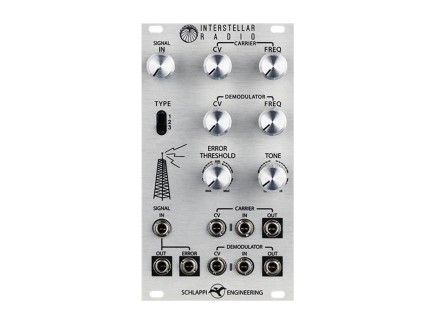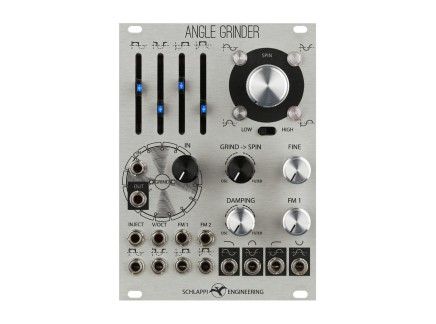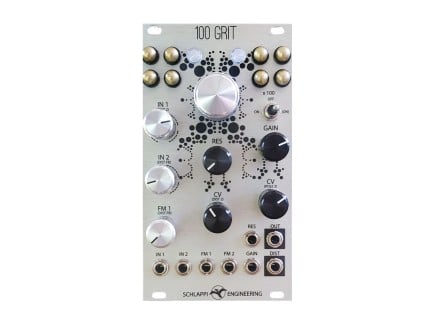Schlappi Engineering is a young Eurorack brand led solely by the musician and engineer Eric Schlappi. Those who are familiar with the modules Schlappi has put out to this day would probably agree that all three—Angle Grinder, Interstellar Radio, and 100 Grit—are anything but average. While each one of the above mentioned devices is very capable and unique in their own right, the underlying current that ties all of Eric's designs together seems to be a capacity to inflict total sonic mayhem. As such, Schlappi's line of Eurorack modules has potential to take central spots in the systems of artists exploring underground musical realms like industrial, techno, dark ambient, drone, noise, and many others.
Recently Eric announced a new module he is working on, the Three Body—a triple digital oscillator with a vast array of tools for sonic shaping. Excited about it, we arranged a livestream with the inventor in hopes of getting a deeper understanding of the newest member of Schlappi Engineering family of modules, as well as to get an overall wider perspective into Eric's workflow, inspirations, and ideas about synthesis. As it was revealed in the chat, Eric set out a goal for creating a complete Schlappi Engineering modular system, and each new module is a step in that direction. Keeping this in mind, let's review the functionality of the current three modules along with the upcoming Three Body.
Interstellar Radio
Interstellar Radio was the first module released by Schlappi, and right off the bat it demonstrated a clear vision now found throughout Eric's work, which is expressed in the design of modules that can act both as sound processors and self-sufficient sound generators.
Interstellar Radio is described by Schlappi as a destructive transmission line, and it's hard to find a better tagline for the module. The design borrows the idea from radio transmission technology (hence the name) in which the signal is converted to and from high frequency pulses, yet here the technique is exploited to tear up audio signals in some of the most intense ways imaginable. Two built-in oscillators with FM and cross-modulation capabilities render IR as a particularly clangorous non-V/oct-friendly take on a complex VCO. In this mode it becomes a great tool for noisy drones and percussion material (when paired with an envelope and vca). Plug a drum beat or a lead/bass line into its input—and brace yourself, as you're about to hear some of the most intense distortion sounds out there. Eric also mentions plugging the Error output back to the input for some particularly gnarly results.
Angle Grinder
It is not particularly easy to describe the Angle Grinder module, as it excels in morphing from one set of functionality to another. Essentially marketed as a quadrature sine wave oscillator, and a waveshaper, the module offers much more than just that.
With nothing plugged into the inputs, and with the Grind/Spin parameter set all the way counterclockwise to OSC, the four outputs function as straightforward sine wave generators with the phase of each set to 0º, 90º, 180º, and 270º respectively. The Grind output provides a waveshaped output, where harmonics are added by changing the positions of the four sliders, either manually or by means of control voltage.
The Grind input is the gateway to access the waveshaper for the external signals. Turning up the Grind parameter knob you start introducing feedback loops into the mix, ruthlessly distorting the waveform. Furthermore, moving the Grind parameter past the 12 o'clock mark takes the module into state variable filter territory. And as Angle Grinder could be set to both audio and low frequency ranges, that effect is dramatically changed at the flick of the switch.
If that wasn't enough, a certain way of patching Angle Grinder can turn it into a strange four-step sequencer. The sliders on the module are comparators, and with Input turned all the way down they compare the phase of the quadrature LFO to zero, effectively becoming sequencer step values. You can also sync the sequencer by running an external clock signal into the Inject input. Things get even crazier when you start turning the Grind/Spin knob, which feeds the sequence back onto itself.
100 Grit
Many of us get excited about modules that have a tactile interface. Hearing sound instantly reacting to physical motion is only natural to us...after all, this is how we interacted with musical instruments for most of history. What is interesting is that it seems to be true for both predictable outputs produced by traditional instruments, as well as complex and chaotic electronic noises as in many circuit bent instruments. The latter seems to be a clear inspiration for Schlappi's 100 Grit.
The module can function as a regular VCA, a filter or a distortion, and it can be easily pushed to the outer edges of sonic extremes. However, what makes it truly unique is Eric's implementation of eight brass touchpoints that add a level of interactivity and unpredictability rarely seen—allowing you to "repatch" the module's inner workings with a simple touch.
Three Body
The mysterious name of the module is inspired by the mind-bending science-fiction novel "The Three-Body Problem"...and that information alone should be a giveaway for the depth and complexity of the upcoming oscillator from Schlappi.
Three Body is an FPGA-based triple digital oscillator with a whopping fourteen waveform outputs. It is designed so that all three oscillators can be used completely independently from each other, or fully intertwined—with the two outside oscillators set to user-definable and voltage-controllable ratios of the center oscillator's frequency. All three oscillators sport both frequency and phase modulation inputs, which opens up a lot of potential for intense tone sculpting.
Being a module designed by Eric Schlappi Three Body excels as a drone and noise device, however it can be as easily turned into a timbrally-rich melody and harmony generator.
So when will we be able to add this beast to our ever-growing racks? As of now, Three Body is still in the final prototyping stages, but Eric promises to have it ready by Fall. Fingers crossed.










